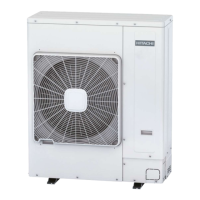6 Optional functions
166
SMGB0064 rev.0 - 08/2011
code “d1” “20” will be displayed if an attempt is made to change the operation mode of any of the indoor units with the
remote control.
Example of wiring diagram of xing the operation mode.
Outdoor unit PCB
A
Power
supply
• A: 3P connector cable.
• X1: Cooling.
• X2: Heating.
• SS1: Fixing operation mode switch.
• SS2: Change over switch
Demand thermo OFF (3)
This is an input function to control the maximum power that the compressor can consume. When this option is turned on,
the outdoor units are stopped completely, and the indoor units go into thermo-OFF. Alarm “10” is displayed on the remote
control. If the switch of this function is disconnected it becomes available again.
Connect the cabling and use the materials as shown in Available ports, see on page 162
Forced stoppage (4)
This is an input function that turns on when the switch receives a signal that causes the compressor and the fan motor of
the indoor unit to stop; alarm “10” displays on a remote-controlled when this option turns on. If the switch of this function is
disconnected it becomes available again.
Connect the cabling and use the materials as shown in Available ports, see on page 162
Current control demand (5/6/7)
This is an input function that turns on when it detects that the frequency of the compressor reaches 50%, 75% or 100%.
The frequency of the compressor is determined when the maximum current reaches the established limit.
Connect the cabling and use the materials as shown in Available ports, see on page 162
If the running current of the outdoor unit exceeds the maximum limit, the unit changes to the thermo-OFF condition. Stop-
page cause code “10” will appear. When the input terminal is opened during the demand current control, the control of the
input terminal is reset.
6.1.4 Description of optional output signals
Operation signal (01)
This optional signal is used to pick up the operation signal. It can be used to turn on or off complementary units of the air-
conditioning system,such as fans, humidiers, etc.
Connect the cabling and use the materials as shown in Available ports, see on page 162
Note that the contact of auxiliary relay X3 is closed when an operation signal is issued.
Alarm signal (02)
This optional signal is used to pick up the activation of safety devices.

